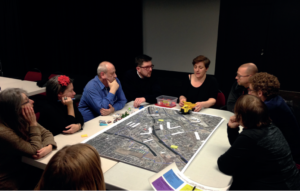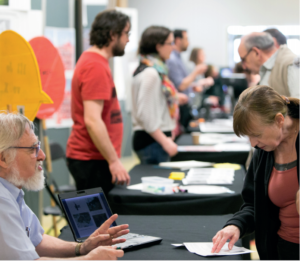Public participation in planning cities is often a messy and imperfect process.
But when conflict and consensus are allowed in this process it is exciting and often produces interesting ideas, said Lisa Bornstein, associate professor at McGill University’s School of Urban Planning.
In one example, Bornstein said the City of Montréal, Canada, wanted to redo its underpasses and were exploring ways to do this. A woman from the community came forward with photos of different underpasses she had taken in her travels. In these underpasses, artists used creative ways to humanize and enliven these spaces.
“Here was a non-planner feeding them ideas,” Bornstein said at a recent UEP colloquium, and city officials decided to change their approach based on the ideas this woman brought to them.
This was just one of many situations Bornstein has examined to try to answer what has been her central question for a decade of research — who shapes the city and how?
Bornstein hopes to synthesize all her findings in a couple of books eventually, but shared some of her ideas at the colloquium Wednesday.
Typically urban development is initiated by three types of actors, Bornstein said. One stems from urban “boosterism” and major pushes for government involvement in city building. Another is initiated by grassroots and other bottom-up efforts. A third is government initiated actions.
Having looked primarily at Montréal, Bornstein said there is a strong tradition of protest in the city, where residents will mobilize for any issue and in any weather. It is here that initiatives from the bottom have worked their way up into the institutional fabric of municipal government. For instance, there are annual summits known as “Choisissons la ville que nous voulons” or “Choose the city we want” and others indicating the city recognizes the value of participatory processes.
The Office de consultation publique de Montréal (OCPM) was one example that Bornstein examined. The OCPM is responsible for holding public meetings and public consultations for city projects from master plans to transit densification plans. The format begins much like a traditional public meeting, Bornstein said, where a group of commissioners presides over the meeting and developers present information, take questions, and give groups and organizations a chance to submit grievances. The commissioners then make their assessments and put together a series of recommendations for the city.
“This process have been accompanied with quite a bit of innovation. You see the standard public meeting, but they’re moving towards all sorts of digital means,” Bornstein said. “They’re reaching the people, displaying different types of designs. There’s use of Facebook, 3D modeling. In one, they had a ‘Chocolate Cake Day’ outside a Metro station. They had sheets of chocolate cake; they blocked out the buildings that are unlikely to change, then they asked people to play, then eat.”
Despite the OCPM’s innovation, however, Bornstein noted that the process is not perfect and that her team made critiques on three different levels.
The government decides which projects go for consultation, which is highly problematic, Bornstein says, because of its ability to direct projects the way it wants. Further, the project is largely designed before it even goes for consultation.
“If (the public) says, ‘No way, we hate it,’ they have to go back to the drawing board,” Bornstein said, adding that the design process can encourage conflict and distrust.
To add to the feelings of distrust, Bornstein noted the OCPM uses a lot of intimidating language, does not give residents enough time to express themselves, and conducts a lot of deals behind the scenes
Finally, Bornstein noted, there is no requirement for follow-up after these consultations. The city council also has the latitude to strike down the recommendations or to adopt some and not others without any requirements for explanation.
“There’s no mechanism for people to engage subsequently,” she said.
Bornstein described several other participatory initiatives, particularly for mega projects, in the area with mixed success.
Some enlightening moments came, she said, when residents were gaining access to public officials for the first time and when these participatory processes embraced conflict and diverse viewpoints. By contrast, Bornstein described some “oh no” moments when there was a reliance on expertise and technical knowledge that could not be questioned, as well as derailment of longstanding plans, and projects that made communities invisible.


